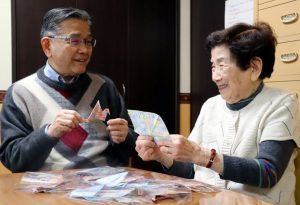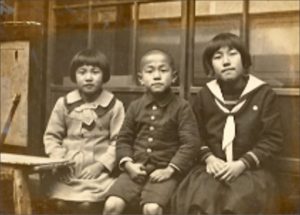94-year-old A-bomb survivor Nakagawa makes 3,000 paper cranes for peace in past three years, gives them to visitors to Hiroshima
Mar. 15, 2025
by Minami Yamashita, Staff Writer
Mineko Nakagawa, 94, an A-bomb survivor living in Minami Ward of Hiroshima, lost her younger brother in the atomic bombing. Praying for peace, she has made more than 3,000 paper cranes over the past three years. Her son, Toshiaki Nakagawa, 74, a Hibakusha Family Member Legacy Successor, gives them to people visiting Hiroshima from Japan and overseas.
Ms. Nakagawa was a third-year student at Hiroshima First Municipal Girls’ High School (now Funairi High School) when she experienced the atomic bombing on August 6, 1945. She was at her home in Funairi-hon-machi (now part of Naka Ward), 1.5 kilometers from the hypocenter. While suffering serious head injuries, she, with her sister Hiroko, who was 2 years older, searched for their younger brother, Norio Ijiri. Norio was a first-year student at Hiroshima Second Middle School (now Kanon High School) and had gone missing while helping demolish buildings to create a fire lane.
They walked around present-day Peace Memorial Park and the school, checking the faces of the people lying on the ground. On August 7, they found Norio lying beside a streetcar track near their house. His face was swollen and he was blind, but they recognized him as they found “Second Middle School, Ijiri” written on a rooftile put next to him. He was conscious and told them that he had been rescued from under the rubble by a stranger. He said to them, “When you grow up, beat America.”
They borrowed a two-wheeled handcart and took him to a relative’s house nearby, Norio called out to all his family members, including ‘Little older sister,’ and died on August 9. “He was the smartest of the four siblings and a good, quiet boy,” said Ms. Nakagawa. As for her girls’ high school, all the first- and second-year students who were exposed to the atomic bomb while working to demolish buildings were killed. Every summer, Ms. Nakagawa visits the memorial monuments for the Second Middle School and the municipal girls’ high school victims and touches the names of her brother and his friends that are engraved on them.
She did not talk about her experience to anyone except her family, but she was inspired when Toshiaki began to work as an A-bomb Legacy Successor for another A-bomb survivor in 2021. She began folding paper cranes for him to give away at lectures and tours of monuments in Peace Memorial Park. She began to enjoy hearing how the visitors reacted when they received the paper cranes. When you pull on the tail, the paper crane moves as if it flapped its wings. Now she folds 30 cranes a day at most and wraps them individually. “I imagine the paper cranes carry my wish and fly all over the world.”
Annilee Rohrscheib, 67, from Illinois, the U.S., took part in a tour to visit monuments in late February. She said the paper cranes reminded her of her mother-in-law, whose younger brother died in Germany during World War II. She gazed at the two paper cranes she was given and added that she wanted to give them to her grandchildren. Toshiaki, who also became a Hibakusha Family Member Legacy Successor in 2022, said, “I want to continue to convey to the whole world the thoughts of the A-bomb survivors, including my mother’s.”
(Originally published on March 15, 2025)
Mineko Nakagawa, 94, an A-bomb survivor living in Minami Ward of Hiroshima, lost her younger brother in the atomic bombing. Praying for peace, she has made more than 3,000 paper cranes over the past three years. Her son, Toshiaki Nakagawa, 74, a Hibakusha Family Member Legacy Successor, gives them to people visiting Hiroshima from Japan and overseas.
Ms. Nakagawa was a third-year student at Hiroshima First Municipal Girls’ High School (now Funairi High School) when she experienced the atomic bombing on August 6, 1945. She was at her home in Funairi-hon-machi (now part of Naka Ward), 1.5 kilometers from the hypocenter. While suffering serious head injuries, she, with her sister Hiroko, who was 2 years older, searched for their younger brother, Norio Ijiri. Norio was a first-year student at Hiroshima Second Middle School (now Kanon High School) and had gone missing while helping demolish buildings to create a fire lane.
They walked around present-day Peace Memorial Park and the school, checking the faces of the people lying on the ground. On August 7, they found Norio lying beside a streetcar track near their house. His face was swollen and he was blind, but they recognized him as they found “Second Middle School, Ijiri” written on a rooftile put next to him. He was conscious and told them that he had been rescued from under the rubble by a stranger. He said to them, “When you grow up, beat America.”
They borrowed a two-wheeled handcart and took him to a relative’s house nearby, Norio called out to all his family members, including ‘Little older sister,’ and died on August 9. “He was the smartest of the four siblings and a good, quiet boy,” said Ms. Nakagawa. As for her girls’ high school, all the first- and second-year students who were exposed to the atomic bomb while working to demolish buildings were killed. Every summer, Ms. Nakagawa visits the memorial monuments for the Second Middle School and the municipal girls’ high school victims and touches the names of her brother and his friends that are engraved on them.
She did not talk about her experience to anyone except her family, but she was inspired when Toshiaki began to work as an A-bomb Legacy Successor for another A-bomb survivor in 2021. She began folding paper cranes for him to give away at lectures and tours of monuments in Peace Memorial Park. She began to enjoy hearing how the visitors reacted when they received the paper cranes. When you pull on the tail, the paper crane moves as if it flapped its wings. Now she folds 30 cranes a day at most and wraps them individually. “I imagine the paper cranes carry my wish and fly all over the world.”
Annilee Rohrscheib, 67, from Illinois, the U.S., took part in a tour to visit monuments in late February. She said the paper cranes reminded her of her mother-in-law, whose younger brother died in Germany during World War II. She gazed at the two paper cranes she was given and added that she wanted to give them to her grandchildren. Toshiaki, who also became a Hibakusha Family Member Legacy Successor in 2022, said, “I want to continue to convey to the whole world the thoughts of the A-bomb survivors, including my mother’s.”
(Originally published on March 15, 2025)









